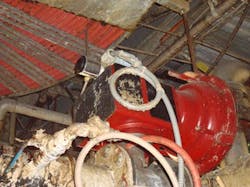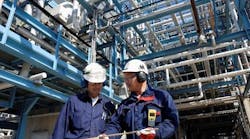Yesterday, Emerson Process Management”s Lara Kauchak fielded questions from Flow Control editor-in-chief, Matt Migliore, on trends and applications of industrial wireless for fluid handling systems. Here, Sandro Esposito, global marketing manager for SMART Products at GE Energy, offers his views on trends in industrial wireless.
Q: From your perspective, how has the wireless movement evolved over the past five years? How is wireless better suited today to meet the needs of industrial fluid handling applications than it was five years ago?
A: Wireless for industrial applications has been available and around for many years, but mostly to link remote site to a central location. What has made the last five years important can be explained in two parts. First, the acceptance of wireless largely due to an influence from all of the consumer goods that are part of our day-to-day lives. Second, the emergence of standards, allowing diversity in field device types and makes that can be interoperable and integrated with a variety of supervisory system.
Q: For what sort of fluid handling applications is wireless currently providing the most end-user benefit?
A: The biggest bang for the buck in utilizing wireless for fluid handling can be applied to applications that are remote or isolated from the distributed control system’s network. For such applications, the end-user can make measurements such as level, pressure, flow, temperature, pH, etc., and relay such information to the supervisory system in a cost-effective manner. For instance, on pipelines wireless transmitters can feedback the flow and pressure to a nearby monitoring station without running any wires. The monitoring station can then feedback this information using satellite communication, radio signals, etc. Nevertheless, continuous control isn’t typically implemented due to the speed of wireless, especially for fast acting control loops, such as pressure and flow.
Q: Over the past few years, there has been a lot of work done in the area of standardization for wireless automation, such as WirelessHART and ISA100. What role do you see these standards movements playing in the future of industrial wireless?
A: First, it provides the industry with open standards for device manufacturer to cost-effectively develop products. This eliminates some of the FUD (fear uncertainty and doubt) from the users knowing that there’s more than one available wireless device for a given application and that devices from various vendors can work seamlessly together within a harmonized backbone. The result is therefore obvious: “more pull by the end users and less push by the vendors.”
A: From a pure measurement and monitoring standpoint of a fluid, several applications can be implemented using wireless, and many customers have been for many years. Now, doing PID control using signals coming from a wireless transmitter and sending a command signal to a control valve with a wireless positioner is a completely different matter, and I think that the technology isn’t there yet for end-user to implement a robust, reliable and sustainable installation. There’s fundamentally a cyber-security concern that hackers could “take over” the control. Also, there’s the control speed to consider, because certain control loops need to process a measurement, compare with a setpoint, and then send a command to a control valve in less than 1 second. Wireless isn’t there yet to provide such robust control. Therefore, there are limited “full wireless” applications that should be considered until the technology evolves with added redundancy, integrated wireless control within the field device, etc.
Q: What are some common application considerations end-users in the fluid handling segment should be making when employing wireless technology?
A: The first that comes to mind is cyber-security. While the protocols, such as WirelessHART and ISA100, do have robust protection against malicious cyber-attacks, there’s always a risk.
From an environmental standpoint, the use of battery-powered devices results in more waste to manage and to dispose. Many manufacturers of battery-powered devices have designed in methods for the device to minimize the transmit/receive
duty cycle in order to have longer battery life. Nevertheless, these batteries will eventually wear out and will require replacement, which means millions of batteries around the world to dispose of. Alternatively, some wireless devices can scavenge power from existing electrical sources or by harvesting energy from vibration, temperature excursion, and obviously from solar power.
Finally, there’s speed. How often the measured control variable requires updating must be considered because the general rule of thumb for robust measuring and controlling is to have a scan rate for the measurement at least three times faster than the process time constant. The WirelessHART and ISA100 standards offer scan rate as low as one second, but other factors must be considered, such as the number of devices on the network to achieve such a scan rate.?
Q: What are some common pitfalls fluid handling end-users should be aware of when employing wireless technology? Is there a typical faux pas you see end-users making when employing wireless solutions?
A: The first one is knowhow. I see too many users jumping in with both feet with new technology without investing up front in the support personnel’s know-how. The same happened with Foundation Fieldbus. There was a reality check once the system integrator left the premises.
The second one would be power. How will the wireless device be powered is something not looked at carefully, especially for those applications involving an adaptor. Most of these adaptors will scavenge power from the incoming 4-20mA signal and therefore will result in a voltage drop. If the added voltage from the wireless adaptor and the field device exceeds the capability from the power source, then the installation will simply not work.
This is mostly seen with analog output cards where a valve positioner is installed on an older control system. Such analog output channel have limited voltage availability to start with for digital valve positioners. So, with the added wireless adaptor, the analog output is simply incapable of powering both devices. Some wireless adaptors on the market have a compliance voltage as low as 1Vdc and therefore work well with most analog output cards. For those adaptors that utilizes a battery, then this isn”t a concern, except for the fact that batteries will need to be replaced eventually.
Q: Looking ahead over the next 5-10 years, how do you see industrial wireless technology evolving going forward? How will the wireless automation solutions of tomorrow be better than the current generation of technologies?A: Within the next five years, we will probably see device manufacturers resolve the constraints related to powering a wireless device without batteries. This will allow end-users to further adopt and implement wireless. In addition, most control system will offer a means to seamlessly integrate variables coming from wireless field devices, which will then provide for more advanced applications using wireless.
Between 5-10 years, I believe that wireless technology will allow field devices to go beyond transmitting, receiving and passing variables to a wireless gateway. The technology will become a communication bus similar to Foundation Fieldbus where field devices can exchange variables to each other in a deterministic way, such that process control will be handled in the field wirelessly.
I can envision handheld devices allowing communication with the wireless grid and showing on the screen the devices around you and their respective location. No need to search for the tucked away transmitter behind a pipe, or the control valve on a pipe rack. Devices will have global positioning capability so that vendors can remotely monitor their health and dispatch support and identify the closest center where there’s a spare. By then, a unified wireless technology will connect any piece of equipment in a processing plant.
www.ge-energy.comTo read Part I of this Q&A series, click here.



